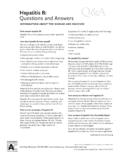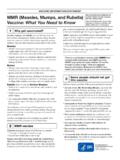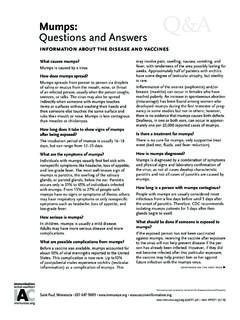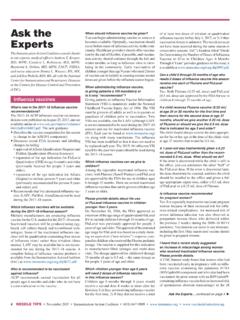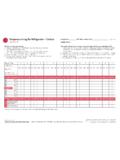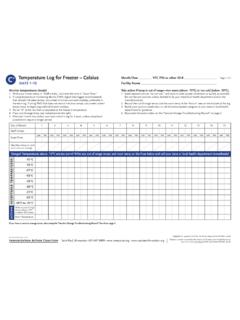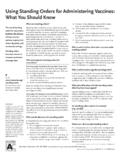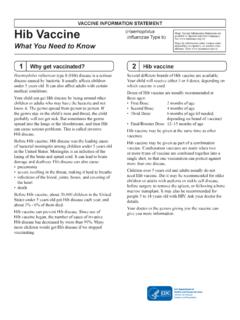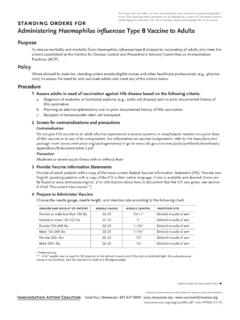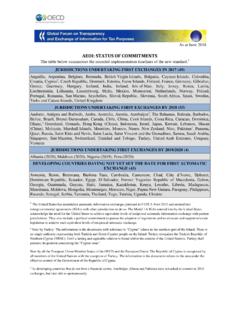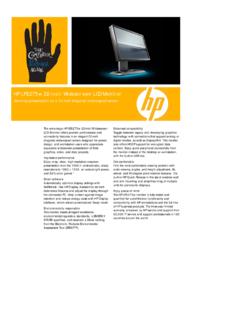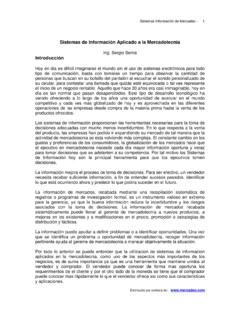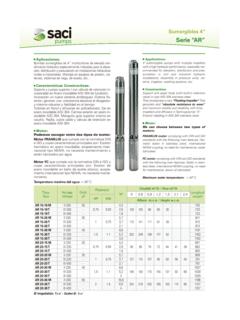Transcription of Summary of Recommendations for Adult …
1 Vaccine name and routePeople for whom vaccination is recommendedSchedule for vaccination administration (any vaccine can be given with another unless otherwise noted)Contraindications and precautions (mild illness is not a contraindication)InfluenzaInactivatedInf luenzavaccine(IIV*)Give IM or ID (intradermally)* includes recom-binant influenza vaccine (RIV3)For people through age 18yrs, consult Summary of Recommen-dations for Child/Teen Immunization at Vaccination is recommended for all adults. Adults age 18 through 64yrs may be given any intramuscular IIV product (Fluzone, Fluvirin, Afluria, Flucelvax, Fluarix, FluLaval), or the intradermal IIV product (Fluzone Intradermal), or RIV3 (FluBlok). Adults age 18 through 64yrs may be given intramuscular IIV (Afluria) with a needle and syringe or using a jet injector (Stratis). Adults age 65yrs and older may be given any standard-dose IIV referenced in the second bullet above, Fluad, or high-dose IIV (Fluzone High-Dose), or RIV3 Live attenuated influenza vaccine (LAIV) should not be used during the 2016 17 influenza season.
2 Give 1 dose every year in the fall or winter. Begin vaccination services as soon as vaccine is available and continue until the supply is depleted. Continue to give vaccine to unvaccinated adults throughout the influenza season (including when influenza activity is present in the community) and at other times when the risk of influenza Previous severe allergic reaction ( , anaphylaxis) to this vaccine, to any of its components, including egg protein. Adults who have experienced a severe reaction to eggs involving symptoms other than hives may receive any age-appropriate influenza vaccine, including RIV3 which does not contain egg protein. The vaccine should be administered in a medical setting ( , a health department or physician office) and should be supervised by a healthcare provider who is able to recognize and manage severe allergic conditions. Precautions Moderate or severe acute illness with or without fever. History of Guillain-Barr syndrome (GBS) within 6 wks following previous influenza vaccination.
3 For adults who experience only hives with exposure to eggs, give any age-appropriate influenza , Tdap(Tetanus, diphtheria, pertussis)Give IMFor people through age 18yrs, consult Summary of Recommen-dations for Child/Teen Immunization at All people who lack written documentation of a primary series consisting of at least 3 doses of tetanus- and diphtheria-toxoid-containing vaccine. A booster dose of Td or Tdap may be needed for wound management, so consult ACIP Tdap only Adults who have not already received Tdap or whose Tdap history is not known. Healthcare personnel of all ages. Give Tdap to pregnant women during each pregnancy (preferred during the early part of gestational weeks 27 through 36), regardless of the interval since prior Td or Tdap. For people who are unvaccinated or behind, complete the primary Td series (3 doses with an interval of 1 2m between dose #1 and #2, and an interval of 6 12m between dose #2 and #3); substitute a one-time dose of Tdap for one of the doses in the series, preferably the first.
4 Give Td booster every 10yrs after the primary series has been completed. Tdap should be given regardless of interval since previous Previous severe allergic reaction ( , anaphylaxis) to this vaccine or to any of its components. For Tdap only, history of encephalopathy not attributable to an identifiable cause, within 7d following DTP/DTaP, or Moderate or severe acute illness with or without fever. History of Guillain-Barr syndrome within 6wks following previous dose of tetanus-toxoid-containing vaccine. History of Arthus-type reaction following a prior dose of tetanus- or diphtheria-toxoid-containing vaccine (including MenACWY); defer vaccination until at least 10yrs have elapsed since the last tetanus toxoid-containing vaccine. For pertussis-containing vaccines only, progressive or unstable neurologic disorder, uncontrolled seizures, or progressive encephalopathy until a treatment regimen has been established and the condition has of Recommendations for Adult Immunization (Age 19 years and older) PAGE 1 OF 5 Immunization Action Coalition Saint Paul, Minnesota 651-6 47-9009 content reviewed by the Centers for Disease Control and Item #P2011 (6/17)This document was adapted from the Recommendations of the Advisory Committee on Immunization Practices (ACIP).
5 To obtain copies of these Recommendations , visit CDC s website at or visit the Immunization Action Coalition (IAC) website at This table is revised periodically. Visit IAC s website at to make sure you have the most current version. For the purposes of calculating intervals between doses, 4 weeks = 28 days. Intervals of 4 months or greater are determined by calendar vaccine series does not need to be restarted, regard-less of the time that has elapsed between CDC. Preventing Tetanus, Diphtheria, and Pertussis Among Adults: Use of Tetanus Toxoid, Reduced Diphtheria Toxoid and Acellular Pertussis Vaccine. Recommen-dations of the Advisory Committee on Immunization Practices (ACIP). MMWR 2006;55(RR-17) name and routePeople for whom vaccination is recommendedSchedule for vaccination administration (any vaccine can be given with another unless otherwise noted)Contraindications and precautions (mild illness is not a contraindication)MMR(Measles,mumps,rubel la)Give SubcutFor people through age 18yrs, consult Summary of Recommendations for Child/Teen Immunization at People born in 1957 or later (especially those born outside the ) should receive at least 1 dose of MMR if they have no laboratory evidence of immunity to each of the 3 diseases or documentation of a dose given on or after the first birthday.
6 People in high-risk groups, such as healthcare personnel (paid, unpaid, or volunteer), students entering college and other post-high school educational institutions, and international travelers, should receive a total of 2 doses. People born before 1957 are usually considered immune, but evidence of immunity (serology or documented history of 2 doses of MMR) should be considered for healthcare personnel. Women of childbearing age who do not have acceptable evidence of rubella immunity or vaccination. Give 1 or 2 doses (see criteria in 1st and 2nd bullets in box to left). If dose #2 is recommended, give it no sooner than 4wks after dose #1. If woman of childbearing-age is found to be rubella susceptible and is not pregnant, give 1 dose of MMR; if she is pregnant, the dose should be given postpartum. This includes women who have already received 1 or 2 doses of rubella-containing vaccine. If 2 or more of the following live virus vaccines are to be given MMR, Var, HZV, and/or yellow fever they should be given on the same day.
7 If they are not given on the same day, space them by at least 28d. May use as post-exposure prophylaxis if given within 3d of exposure. Contraindications Previous severe allergic reaction ( , anaphylaxis) to this vaccine or to any of its components. Pregnancy or possibility of pregnancy within 4wks. Severe immunodeficiency ( , hematologic and solid tumors; receiving chemotherapy; congenital immunodeficiency; long-term immunosuppressive therapy; people with human immunodeficiency virus (HIV) infection who are severely immunocompromised. note: HIV infection is NOT a contraindication to MMR for those who are not severely immunocompromised ( , CD4+ T-lympho-cyte counts are greater than or equal to 200 cells/ L) for Moderate or severe acute illness with or without fever. If blood, plasma, and/or immune globulin were given in past 11m, see ACIP s General Recommendations on Immunization2 regarding time to wait before vaccinating. History of thrombocytopenia or thrombocytopenic : If TST (tuberculosis skin test) and MMR are both needed but not given on same day, delay TST for at least 4wks after (chickenpox)(Var)Give SubcutFor people through age 18yrs, consult Summary of Recommendations for Child/Teen Immunization at All adults without evidence of immunity.)
8 Note: Evidence of immunity is defined as written documentation of 2 doses of varicella vaccine; a history of varicella disease or herpes zoster (shingles) based on healthcare-provider diagnosis; laboratory evidence of immunity or confirmation of disease; and/or birth in the before 1980, with the exceptions that follow. Healthcare personnel (HCP) born in the before 1980 who do not meet any of the criteria above should be tested or given the 2-dose vaccine series. If testing indicates they are not immune, give the 1st dose of varicella vaccine immediately. Give the 2nd dose 4 8 wks later. Pregnant women born in the before 1980 who do not meet any of the criteria above should either 1) be tested for susceptibility during pregnancy and if found susceptible, given the 1st dose of varicella vaccine postpartum before hospital discharge, or 2) not be tested for susceptibility and given the 1st dose of varicella vaccine post-partum before hospital discharge. Give the 2nd dose 4 8wks later.
9 Give 2 doses. Dose #2 is given 4 8wks after dose #1. If dose #2 is delayed, do not start over. Just give dose #2. If 2 or more of the following live virus vaccines are to be given MMR, Var, HZV, and/or yellow fever they should be given on the same day. If they are not given on the same day, space them by at least 28d. May use as postexposure prophy-laxis if given within 5d of Previous severe allergic reaction ( , anaphylaxis) anaphy- lactic reaction to this vaccine or to any of its components. Pregnancy or possibility of pregnancy within 4wks. People on long-term immunosuppressive therapy or who are immunocompromised because of malignancy and primary or acquired immunodeficiency, including HIV/AIDS (although vaccination may be considered if CD4+ T-lymphocyte counts are greater than or equal to 200 cells/ ). People with isolated B-lymphocyte deficiency may receive varicella Moderate or severe acute illness with or without fever. If blood, plasma, and/or immune globulin (IG or VZIG) were given in past 11m, see ACIP s General Recommendations on Immunization2 regarding time to wait before vaccinating.
10 Receipt of specific antivirals ( , acyclovir, famciclovir, or valacyclovir) 24hrs before vaccination, if possible; delay resumption of these antiviral drugs for 14d after of Recommendations for Adult Immunization (Age 19 years and older) PAGE 2 OF 5 IAC (6/17)1 CDC. Prevention of Measles, Rubella, Congenital Rubella Syndrome, and Mumps, 2013. Summary Recommendations of the Advisory Committee on Immunization Practices (ACIP). MMWR 2013;62 (No. RR-4) CDC. General Recommendations on Immunization Recommendations of the Advisory Committee on Immunization Practices (ACIP). MMWR 2011;60 (No. RR-2) CDC. Prevention of Varicella. Recommendations of the Advisory Committee on Immunization Practices (ACIP). MMWR 2007;56(No. RR-4):24 name and routePeople for whom vaccination is recommendedSchedule for vaccination administration (any vaccine can be given with another unless otherwise noted)Contraindications and precautions (mild illness is not a contraindication)Hepatitis A(HepA; Havrix, Vaqta)Give IMBrands may be used people through age 18yrs, consult Summary of Recommendations for Child/Teen Immunization at All adults who want to be protected from hepatitis A virus (HAV) infection.
